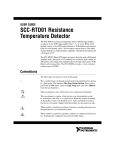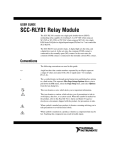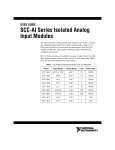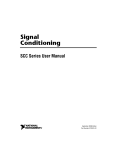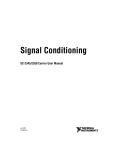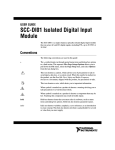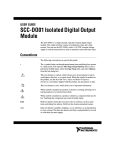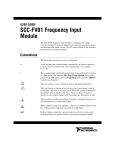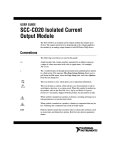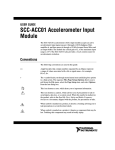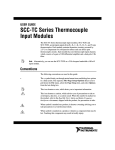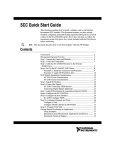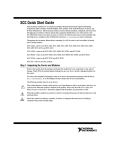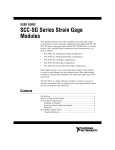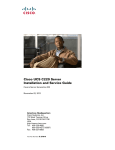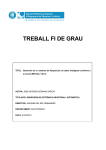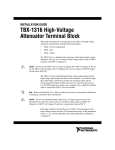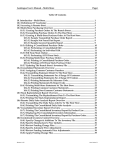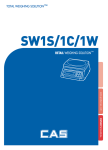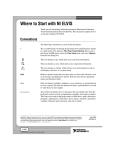Download SCC-A10 Voltage Attenuator Module
Transcript
USER GUIDE SCC-A10 Voltage Attenuator Module The SCC-A10 voltage attenuator module accepts up to two voltage sources of 60 V maximum amplitude and attenuates each voltage by a factor of 10. A differential instrumentation amplifier buffers each input signal. The SCC-A10 contains circuitry capable of protecting E/M Series DAQ devices for input signals up to 60 VDC. Conventions The following conventions are used in this guide: <> Angle brackets that contain numbers separated by an ellipsis represent a range of values associated with a bit or signal name—for example, AO <3..0>. » The » symbol leads you through nested menu items and dialog box options to a final action. The sequence File»Page Setup»Options directs you to pull down the File menu, select the Page Setup item, and select Options from the last dialog box. This icon denotes a note, which alerts you to important information. This icon denotes a caution, which advises you of precautions to take to avoid injury, data loss, or a system crash. When this symbol is marked on the product, refer to the Read Me First: Safety and Radio-Frequency Interference document, shipped with the product, for precautions to take. When symbol is marked on a product, it denotes a warning advising you to take precautions to avoid electrical shock. When symbol is marked on a product, it denotes a component that may be hot. Touching this component may result in bodily injury. bold Bold text denotes items that you must select in software, such as menu items and dialog box options. Bold text also denotes parameter names. italic Italic text denotes variables, emphasis, a cross reference, or an introduction to a key concept. Italic text also denotes text that is a placeholder for a word or value that you must supply. monospace Text in this font denotes text or characters that you should enter from the keyboard, sections of code, programming examples, and syntax examples. This font is also used for the proper names of disk drives, paths, directories, programs, subprograms, subroutines, device names, functions, operations, variables, filenames, and extensions. SC-2345 SC-2345 refers to both the SC-2345 connector block and the SC-2345 configurable connector. SCC SCC refers to any SCC Series signal conditioning module. What You Need to Get Started To set up and use the SCC-A10, you need the following items: ❑ Hardware – SCC-68 or – SC-2345/2350 with one of the following: • SCC-PWR01 • SCC-PWR02 and the PS01 power supply • SCC-PWR03 (requires a 7 to 42 VDC power supply, not included) – One or more SCC-A10 – 68-pin E/M Series DAQ device – 68-pin cable – Quick Reference Label ❑ Software – The latest version of NI-DAQmx ❑ Documentation – SCC-A10 Voltage Attenuator Module User Guide – SCC-68 User Guide or – SC-2345/2350 User Manual – SCC Quick Start Guide SCC-A10 Voltage Attenuator Module User Guide 2 ni.com – Read Me First: Safety and Radio-Frequency Interference – Documentation for your hardware – Documentation for your software ❑ Tools – 1/8 in. flathead screwdriver – Numbers 1 and 2 Phillips screwdrivers – Wire insulation stripper Software scaling of measurements is not supported on the Macintosh operating system. Refer to the SCC-A10 Module Pin Assignments section. Note You can download NI documents from ni.com/manuals. To download the latest version of NI-DAQmx, click Download Software at ni.com. Device Specific Information For general SCC module installation and signal connection information, and information about the SC-2345/2350 and SC-68, refer to the SCC Quick Start Guide, available for download at ni.com/manuals. Note Installing the Module Caution Refer to the Read Me First: Safety and Radio-Frequency Interference document before removing equipment covers or connecting/disconnecting any signal wires. You can plug the SCC-A10 into any analog input socket on the SC-2345/2350 or SCC-68. The socket you choose determines which E/M Series DAQ device channels receive the SCC-A10 signals, as explained in the SCC Quick Start Guide. For single-stage input conditioning, plug the SCC-A10 into any slot of the SC-68, or any socket of the SC-2345/2350 J(X+1), where X is 0 to 7. Connect the input-signal wires to the module as described in the SCC Quick Start Guide. If you use the SCC-A10 in a dual-stage configuration in an SC-2345, the SCC-A10 must be the first-stage module. Plug it into any socket J(X+9) and plug the second-stage SCC into socket J(X+1), where X is 0 to 7. Connect the input-signal wires to the SCC-A10 as described in the SCC Quick Start Guide. The SC-2345 connects the output signals of the SCC-A10 to the © National Instruments Corporation 3 SCC-A10 Voltage Attenuator Module User Guide inputs of the second-stage SCC. An example of dual-stage conditioning is an SCC-A10 followed by a lowpass filter module (SCC-LPXX). Sockets J9 to J16 of the SC-2345 are also available for digital input/output (DIO) conditioning or control. Refer to the SC-2345/2350 User Manual for more information about configuring, connecting, and installing SCC modules. Connecting the Input Signals The signal names have changed. Refer to ni.com/info and enter rdtntg to confirm the signal names. Note Each screw terminal is labeled by pin number <1..4>. Pins 1 and 2 form a differential channel routed to E/M Series DAQ device channel X+8, and pins 3 and 4 form a second differential channel routed to E/M Series DAQ device channel X. The value of X is determined by the number of the SC-2345/2350 socket where you plug in the module, J(X+1) or J(X+9) or the slot number on the SCC-68. The signal source can be floating or ground-referenced. Floating signal sources do not require bias resistors to ground with the SCC-A10. Figure 1 shows the SCC-A10 signal connections. Signal Source SCC-A10 4 E/M Series DAQ Device Overvoltage Protection + – + – 3 AI (X ) Overvoltage Protection AI SENSE 2 AI GND Overvoltage Protection + – + – 1 AI (X+8) Overvoltage Protection Signal source may be floating or ground-referenced. Figure 1. SCC-A10 Signal Connections SCC-A10 Voltage Attenuator Module User Guide 4 ni.com For information about how to configure the SCC-A10 module using NI-DAQmx, refer to the SCC Quick Start Guide. Using the SCC-A10 when Scaling Voltage Measurements If you configured the SCC-A10 using Measurement & Automation Explorer (MAX) and you are using NI-DAQ, the voltage reading you get from the E/M Series DAQ device accounts for the voltage scaling effect of the SCC-A10. Otherwise, because the voltage measurement from the E/M Series DAQ device is one-tenth of the voltage applied at the SCC-A10 input, you must multiply the voltage reading from the E/M Series DAQ device by 10 to get the correct SCC-A10 input voltage. Specifications Note In order for the SCC-A10 to perform according to the specifications in this guide, the ±15 V power supply you use must be accurate to within 5%. These ratings are typical at 25 °C unless otherwise stated. Analog Input Number of input channels ...................... 2 DIFF Input range......................................... ±60 VDC Input impedance..................................... 1 MΩ (powered on or off) Gain error .......................................... ±0.14% of reading max1 Gain-error temperature coefficient........ ±0.006% of reading/°C max Offset error ........................................ ±6.5 mV max (referred to input [RTI]2) Offset-error temperature coefficient...... ±80 µV/°C max (RTI) Nonlinearity ....................................... ±0.004% of full scale Common-mode rejection ratio ............... 60 dB min (DC to 60 Hz) 1 2 Temperature range is 23 °C ± 5 °C. Calculated with respect to the input range © National Instruments Corporation 5 SCC-A10 Voltage Attenuator Module User Guide Dynamic Response Bandwidth (–3 dB) .................................10 kHz Output settling time to within 0.01% of nominal input voltage .............15 µs Output slew rate......................................0.75 V/µs min Power Requirement Analog power .........................................100 mW max +15 V ................................................3.2 mA max –15 V ...............................................3.2 mA max Digital power (+5 V)................................0.0 mA Physical 1.87 cm (0.74 in.) 7.93 cm (3.12 in.) 3.55 cm (1.4 in.) Figure 2. SCC-A10 Dimensions Weight ....................................................29 g (1.0 oz) I/O connectors.........................................One 20-pin right-angle male connector, one 4-pin screw terminal Wire gauge range....................................24 to 12 AWG SCC-A10 Voltage Attenuator Module User Guide 6 ni.com Maximum Working Voltage (Signal + common-mode) each input should remain within 60 VDC of ground. Maximum working voltage refers to the signal voltage plus the CMV. Channel-to-earth (inputs) ....................... 60 VDC, Measurement Category I Channel-to-channel (inputs)................... 60 VDC, Measurement Category I Caution This device is rated for Measurement Category I and is intended to carry signal voltages no greater than 42.4 Vpeak or 60 VDC. Do not use this device for connection to signals or for measurements within Categories II, III, or IV. Environmental Operating temperature............................ 0 to 50 °C Storage temperature ............................... –20 to 70 °C Humidity ................................................ 10 to 90% RH, noncondensing Maximum altitude .................................. 2,000 m Pollution Degree (indoor use only) ........ 2 Safety The SCC-A10 is designed to meet the requirements of the following standards of safety for electrical equipment for measurement, control, and laboratory use: • IEC 61010-1, EN 61010-1 • UL 61010-1 • CAN/CSA-C22.2 No. 61010-1 Note For UL and other safety certifications, refer to the product label, or visit ni.com/certification, search by model number or product line, and click the appropriate link in the Certification column. © National Instruments Corporation 7 SCC-A10 Voltage Attenuator Module User Guide Electromagnetic Compatibility Emissions................................................EN 55011 Class A at 10 m FCC Part 15A above 1 GHz Immunity ................................................EN 61326:1997 + A2:2001, Table 1 EMC/EMI ...............................................CE, C-Tick, and FCC Part 15 (Class A) Compliant Note For EMC compliance, operate this device with shielded cabling. CE Compliance The SCC-A10 meets the essential requirements of applicable European Directives, as amended for CE marking, as follows: Low-Voltage Directive (safety)..............73/23/EEC Electromagnetic Compatibility Directive (EMC) .....................................89/336/EEC Refer to the Declaration of Conformity (DoC) for this product for any additional regulatory compliance information. To obtain the DoC for this product, visit ni.com/certification, search by model number or product line, and click the appropriate link in the Certification column. Note SCC-A10 Voltage Attenuator Module User Guide 8 ni.com SCC-A10 Module Pin Assignments Figure 3 shows the I/O connector pins on the bottom of the module. 1 Pin 1 2 Pin 2 3 1 4 2 3 Pin 19 4 Pin 20 Figure 3. SCC Module Bottom View Table 1 lists the signal corresponding to each pin. AI (X) and AI (X+8) are the analog input signal channels of the E/M Series DAQ device. AI GND is the analog input ground signal and is the reference for AI (X) and AI (X+8). A GND is the reference for the ±15 V power supply. AI GND and A GND connect to the SC-2345/2350 at the SCC-PWR connector. Table 1. SCC-A10 Module Pin Assignments © National Instruments Corporation Pin Number Signal 1 E/M Series AI (X) 2 E/M Series AI GND [AI (X) REF] 3 — 4 E/M Series AI (X+8) 5 — 6 E/M Series AI GND 7 — 8 E/M Series AI GND [AI (X+8) REF] 9 — 10 — 9 SCC-A10 Voltage Attenuator Module User Guide Table 1. SCC-A10 Module Pin Assignments (Continued) Pin Number Signal 11 A GND 12 — 13 +15 V 14 –15 V 15 — 16 — 17 — 18 — 19 — 20 — National Instruments, NI, ni.com, and LabVIEW are trademarks of National Instruments Corporation. Refer to the Terms of Use section on ni.com/legal for more information about National Instruments trademarks. Other product and company names mentioned herein are trademarks or trade names of their respective companies. For patents covering National Instruments products, refer to the appropriate location: Help»Patents in your software, the patents.txt file on your CD, or ni.com/patents. © 2001– 2005 National Instruments Corporation. All rights reserved. 371067C-01 Dec05










